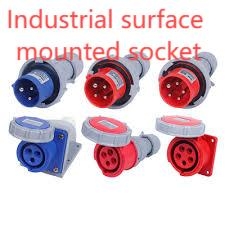Early planning often determines long-term system reliability, which is why choosing the right Industrial surface mounted socket during layout design reduces costly retrofits and simplifies maintenance, and why a correctly specified Industrial surface mounted socket improves uptime, operator safety, and adaptability across changing production requirements. This guide walks through practical selection criteria, installation tips, and lifecycle thinking so facility teams and engineers can deploy surface-mounted power interfaces that stay dependable for years.
Assessing Application Needs and Site Constraints
Start by listing the electrical loads the socket will serve: continuous currents, motor inrush, harmonic content, and whether sensitive electronics share the feed. Next layer in site constraints—exposure to chemicals, constant vibration, potential physical impact, washdown requirements, and proximity to traffic or forklifts. These constraints determine mechanical protection level, ingress rating, contact plating, and whether locking or tamper-proof features are necessary. Early collaboration between electrical and mechanical teams prevents specification mismatches that often surface only after commissioning.
Mechanical Construction and Contact Technology
Durability begins with a robust housing and contact system. Look for housings made from reinforced polymers or powder-coated metals with rounded edges to resist knocks. Contact designs—spring-loaded, multi-pin, or silver-plated—affect insertion force, contact resistance, and cycle life. For high-cycle use, choose contacts rated for many mating operations and with replaceable contact modules so maintenance can extend service life without replacing the entire assembly. Strain-relief features and keyed couplings reduce accidental disconnections in dynamic environments.
Environmental Protection and Sealing Best Practices
Ingress protection is more than a rating on paper; it’s a system. Specify continuous gaskets, sealed mating interfaces, and correctly sized cable glands that preserve the enclosure’s rating after wiring. For washdown zones or outdoor exposures, target higher IP/NEMA levels and insist on corrosion-resistant fasteners and hinge mechanisms. Avoid ad-hoc field penetrations—use factory gland plates or approved accessory kits to maintain sealing performance. Finally, validate protection in the as-installed state: a glanded, wired assembly can behave very differently from an empty box tested in a lab.
Thermal Management and Component Layout
Even modest power points can create heat stress if components are cramped. Plan internal layouts to separate heat sources from sensitive controls and create clear convection pathways. Passive heat-spreading using conductive mounting plates often suffices for moderate loads; for higher dissipation, filtered fans, thermostatic blowers, or compact air-to-air exchangers can be used without compromising ingress protection when properly designed. Also, specify conductor sizes and terminal torque values that limit resistive heating; loose terminations are a frequent source of service failures.
Installation Workflows That Preserve Ratings
Installation technique determines long-term reliability. Use calibrated torque tools for terminals and glands, follow manufacturer conductor-prep instructions, and fit glands in a consistent order to maintain seal compression. Label every penetration and document as-built gland configurations so future teams avoid accidental seal breaches. Where possible, choose units with installer-friendly features—removable gland plates, captive screws, and pre-punched mounting templates—to reduce field drilling and preserve original protection. A concise commissioning checklist (continuity, insulation resistance, and a thermal-run test) validates that the socket is ready for service.
Maintenance, Spares, and Lifecycle Planning
Define a maintenance cadence from day one. Routine checks should include gasket compression, fastener torque, and visual inspection of terminations for corrosion or moisture trails. Maintain a small spares kit—replacement gaskets, common glands, and spare contact modules—to enable rapid repairs. Track mating cycles and service hours if possible; heavily used connectors should be preemptively replaced based on measured wear rather than waiting for failure. Standardizing on a family of compatible sockets across a facility reduces spare-part complexity and speeds recovery.
Safety Integration and Operational Considerations
Where worker safety is critical, integrate interlocks, locking collars, or auxiliary contacts that feed status back to control systems. For hot-pluggable loads, staged-contact designs or pre-connection grounding pins reduce arcing risk. Ensure lockout/tagout procedures and visible labeling are implemented so maintenance teams can isolate power safely. Ergonomic placement—at appropriate heights and away from traffic paths—reduces accidental damage and speeds inspection.
Procurement Tips and Supplier Evaluation — Nante Support Options
When evaluating suppliers, require third-party IP/NEMA test reports, corrosion-test data, and cycle-life test results for the contact systems. Ask for CAD models and sample units for pre-installation fit checks. Confirm accessory ecosystems—blanking plates, locking collars, surge protection modules—are available so upgrades don’t force field modifications. Choose vendors that provide clear installation guides, commissioning checklists, and responsive technical support to shorten troubleshooting time in the field.
Real-World Use Cases and Final Recommendations
Surface-mounted sockets shine in flexible manufacturing cells, temporary test rigs, and retrofit spaces where wall penetrations are impractical. In practice, most failures trace back to improper gland selection, loose terminations, or thermal overloads—issues preventable with proper specification, installation discipline, and scheduled inspections. Prioritize correct sealing, adequate thermal margins, and an accessory ecosystem that supports future changes. With these considerations in place, surface-mounted power points become long-lived, low-maintenance assets.
Thoughtful selection and disciplined installation change a potential weak point into a reliable service interface. Prioritize material choice, sealing integrity, thermal planning, and installer-friendly features for dependable field performance. For product details, accessories, and technical support, visit www.nante.com
